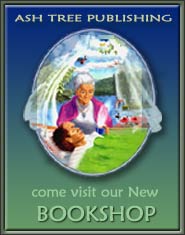 |
Wise Woman Wisdom ...
Herbal Adventures
with Susun S Weed
On Horseback in Provence
by Susun Weed
|
 |
Herbal Adventures with Susun S Weed
On Horseback in Provence
as seen printed in www.sagewoman.com
It's the first day of my week-long horseback trip in Provence, the South of France. 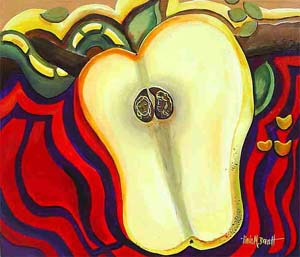 Beneath my feet (and my horse's hooves) aromatic and beautiful plants that I know as cultivated, sometimes pot-bound, specimens are growing wild: grey bitter wormwood (Artemisia absinthium), heavy-headed fennel (Foeniculum vulgare), ground-hugging thyme (Thymus vulgaris), spicy lavender (Lavendula dentata), and heart-warming rosemary (Rosmarinus off.). Each step we take releases sharp, heady fragrances. Beneath my feet (and my horse's hooves) aromatic and beautiful plants that I know as cultivated, sometimes pot-bound, specimens are growing wild: grey bitter wormwood (Artemisia absinthium), heavy-headed fennel (Foeniculum vulgare), ground-hugging thyme (Thymus vulgaris), spicy lavender (Lavendula dentata), and heart-warming rosemary (Rosmarinus off.). Each step we take releases sharp, heady fragrances.
Here in the foothills of the Luberon mountains, the searing Mediterranean sun beats down on rocky, dry soil -- ideal conditions to encourage plants to produce an abundance of volatile oils. Volatile (that is, easily released) oils, such as those in lavender, are strong-smelling and have strong medicinal properties as well. Numerous plants in the mint family (the Lamiaceae, formerly the Labiatae) are especially valued for their volatile oils, including basil, bergamot, catnip, hyssop, lavender, lemon balm, marjoram, oregano, peppermint, rosemary, sage, spearmint, and thyme.
At inns along the way as I rode the trails of Provence, I was served wonderful teas made from fresh thyme. With woody stalks as rough as cedar, this mountain thyme nonetheless released prodigal amounts of volatile oils very quickly. Just inhaling the vapor from the tea seemed guaranteed to prevent upper respiratory infections for a week. Drinking it felt like imbibing the essence of an impassioned romp in the fields with a very special friend.
Plants produce volatile oils to protect themselves from being eaten by things small (insects) and large (herbivores). And these oils can, in fact, have poisonous effects on a wide variety of life forms, including ourselves. Herbalists say volatile oils are antibacterial (kill bacteria), antifungal (kill fungi), antimicrobial (kill microbes), antiseptic (kill septic organisms such as cholera, typhus, and e. coli), and even insecticidal (kill insects) and anthelmintic (kill parasitic worms).
When extracted from the plants, volatile oils are called essential oils. An essential oil is a highly concentrated, drug-like substance which can cause severe side effects if used incorrectly. It concerns me that essential oils, which have killed several adults and children when taken internally, have been presented to the American public as a safe, warm-fuzzy, natural remedy. Out of respect for the plants and the many tons of them it takes to produce a little essential oil, I rarely use essential oils. Also, I prefer the safety and pleasure of using the plants themselves with their effective and amazing volatile oils.
Volatile oils are easily transported from fresh plants to hot water. A cup of catnip tea, or lemon balm tisane, smells heavenly because the aromatic oils are vaporizing, and it tastes great because of the volatile oils dissolved in the water. Breathing in the hot steam sends volatile oils up into the sinuses and down into the lungs, where they counter colds, the flu, bronchitis, even headaches, and quite possibly anthrax. Drinking the brew brings those oils into the digestive system, where they can counteract flatulence (intestinal gas), improve digestion of fats, and counter cancer-causing compounds and food poisoning bacteria. No wonder they have been prized for centuries by cooks as well as medicine makers!
Mint family plants are exceptionally easy to grow, requiring little beyond a sunny spot and occasional watering. Rich soil, fertilizer, and lots of water are not only not needed, they are counterproductive, producing plants that have little taste and aroma. Most mint family plants are quite happy in pots if you are a city herbalist. And although they aren't much to look at, their varied and strong smells, which can be released by brushing the plants, more than make up for their lack of showy flowers and fancy leaves.
I prefer to let my gardens grow wild, and the mints are more than happy to help. Beds of bergamot, lemon balm, motherwort, fuzzy mint, and sage stand up to most weeds with little or no help from me. Skullcap (Scutellaria lateriflora) and Lycopus inhabit the woods, and thyme forms ever widening mats once planted. But rosemary and lavender must keep in pots which are summered in the garden and brought indoors during my cold Catskill winters. The mints can actually be used rather interchangeably -- most are stimulants/sedatives, acting on the digestive and nervous systems -- so I really needn't bother. But who can resist the allure of grey-green lavender and glossy-green rosemary? Not me!
To maintain the health of my rosemary bush during the winter, I keep it well pruned by pinching off the growing tips. I use them, fresh or dried, to make a full-bodied tea, a bone- building vinegar, and a special seasoning for lentil soup. Dried and powdered, rosemary has a reputation as a wound healer of some skill. Strong infusion goes to the head of the class as the herb most likely to be used to improve the health of the scalp and hair; just pour it over your freshly-washed hair and allow it to dry.
Herbal pioneer, Juliette de Bairacli Levy, says she learned to love rosemary when she lived with the Gypsies, who use it in a wide variety of ways. "As an herbalist," she writes, "if my name could be associated with any plant I would choose rosemary, I use it more than any other plant and I love it most of all." The Gypsies taught her how to make a special skin tonic (and general cure-all) from flowering rosemary, known as "The Queen of Hungary's Water." An Arab herdsman that she befriended confided in her his secret for producing delicious goats' milk: pasture the flock where rosemary grows! This is equally good advice for mothers, too, she asserts, improving not only the taste but the quantity and nutritional value of her milk.
Ophelia tells us that rosemary is for remembrance, and modern science agrees. The antioxidants found in profusion in rosemary (in fact, in all mints, especially self heal, Prunella vulgaris) counter memory loss and senility. Those same antioxidants help counter cancer and fight wrinkles. They also strengthen the heart and reduce blood pressure, effects I am more used to ascribing to motherwort (Leonurus cardiaca), but which are well validated for rosemary.
Provence is only a memory now. But it is a memory that is easy to awaken. I have only to run my hands through the rosemary and inhale.
Green Blessings.
Susun Weed

Herbs for Longevity and Radiant Well Being - 2 CD Set
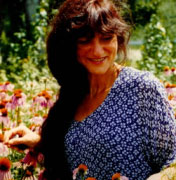 Herbs for Longevity and Radiant Well Being CD Herbs for Longevity and Radiant Well Being CD
Rosemary Gladstar
Breitenbush Hot Springs Herbal Conference 1998 Length - 1 Hour/28 Minutes - $22.50
Using herbs & common sense health principles to restore vitality & promote vibrant well being. the emphasis will be on common North American tonic & adaptogenic herbs.
Price: $22.50
Order Herbs for Longevity and Radiant Well Being CD Set in our Bookshop

Healing
Wise
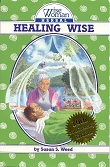 by Susun
S. Weed by Susun
S. Weed
Introduction by Jean Houston.
Superb herbal in the feminine-intuitive mode. Complete instructions for using common plants for food, beauty, medicine, and longevity. Seven herbs -- burdock, chickweed, dandelion, nettle,
oatstraw, seaweed, and violet -- are explored in depth.
A Special Tenth Anniversary edition of this
classic herbal, profusely illustrated. 312 pages.
Retails for $21.95
Read a Review
Order HEALING WISE in our Bookshop
I just started reading your book, Healing Wise. Your
humor and approach to life seem so "down-to-earth",
just like your favorite powerful weeds. Thank you for sharing
and nourishing! ~ Diane

 NEW NEW
Sacred and Herbal Healing Beers:
The Secrets of Ancient Fermentation
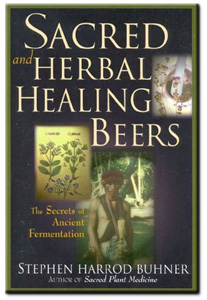 by Stephen Harrod Buhner by Stephen Harrod Buhner
This is the first comprehensive book ever written on the sacred aspects of indigenous, historical psychotropic and herbal healing beers of the world.
Paperback: 450 pages
Price: $19.95
"Filled with nourishment for the soul, body, and mind, this book is a unique view of the intersection between herbal medicine and fermentation. It will delight anyone interests in herbs, honey, brewing and folktales. Great Book!" -- Susun S. Weed
Order Sacred and Herbal Healing Beers in our Bookshop

LOVE LETTERS
First I want to start out by saying that I love your website!!!!!!!!!!!
I have two books written by you, New Menopausal Years the Wise Woman Way and Healing the Wise Woman Way. They have changed my way of thinking about healing and herbs. One day I hope to go back to New York with my husband and visit the land where he grew up…
thank you so much, even just having you read this email I feel blessed!
green blessings,
elsa
read more...
|
|






